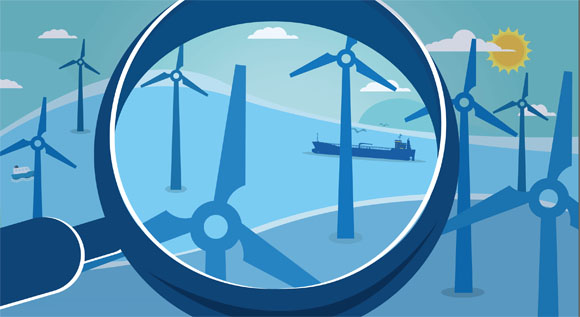How does an offshore wind farm work?
Wind, waves, alternating and direct current: offshore wind energy is regarded as a cornerstone of the clean energy transition and supplies millions of people with green electricity. But how does an offshore wind farm work? And how does the electricity get from sea to land? Come and pay a quick visit.
 © BMWK
© BMWK
This is what it’s all about: offshore wind farms off the coast of the North Sea and Baltic Sea produce green electricity for millions of people.
In 1991, even before the word „Energiewende” (energy transition) appeared in a German dictionary, the world’s first ever offshore wind farm was established off the Danish island of Lolland. It was not until almost 20 years later that the first offshore wind farm in open water began operations – alpha ventus. When it comes to the future of wind energy off the shores of Germany, the North Sea is still the focus. It might increase its generation capacity tenfold from now till 2050. Germany wants to increase its capacities to at least 30 gigawatts by 2030, and 70 gigawatts by 2045. For more information, please click here.
Sea as far as the eye can see
Many areas cannot be considered for wind farms for reasons of nature and species conservation or other activities, such as shipping, fisheries or military uses. Suitable areas are therefore identified as part of marine spatial planning and special planning for offshore wind energy. This planning ensures that the delineated areas are used as efficiently as possible and that the offshore wind farms and offshore grid connections to transport the electricity to land go onstream at the same time.
Staying with the wind
On the high sea, the wind blows much more constantly than on land, but the wind energy installations need to be much more resilient. Because unlike installations on land, a large part of these marine giants is below the surface and is thus exposed not only to the strong sea winds, but also to currents, waves and tides.
Today, turbines with a capacity of eleven megawatts (MW) are already being installed, and it is expected that capacities of 15 MW and even up to as much as 20 MW will be operating before the end of this decade. The total capacity of offshore wind farms is therefore several hundred megawatts, and in future will generally pass the one gigawatt mark.
The wind blowing over the sea sets the huge rotor blades in motion. This movement is converted into energy in the generator nacelle as follows: the rotor blade turns the main shaft and a gear unit transfers the rotational motion to a fast-rotating high-speed shaft. To this shaft is attached a magnet that rotates inside the generator between coils made of conductive wire. This produces electricity.
How the electricity is transported depends on where the wind farm is
The electricity generated in the turbines at the wind farm is fed into an offshore converter station, which transports it to land as direct current via high-voltage cables. Transferring the electricity as direct current minimises transmission losses. As offshore wind energy installations can nowadays produce direct current on the 66 kV voltage level, there is no longer any need to build a substation especially for the wind farm to collect the electricity and transform it to a higher voltage level. Once it reaches dry land, the electricity from the sea is transformed into alternating current in a substation, transformed to the correct voltage, and fed into the public grid.
If a wind farm is not far from the shore, a submarine cable will take the electricity to the next onshore connection point. Here the electricity is transferred via alternating current cables at a low voltage (220 kV). This is the case for all offshore wind farms in the Baltic Sea, for instance, because they are built closer to the shore.
Over the past few years, the costs of electricity production – installation and maintenance costs, for instance – from offshore wind energy have sunk rapidly, partly as a result of acquired knowledge. At the same time, the energy yield has grown many times over, without the overall costs increasing to the same extent.

